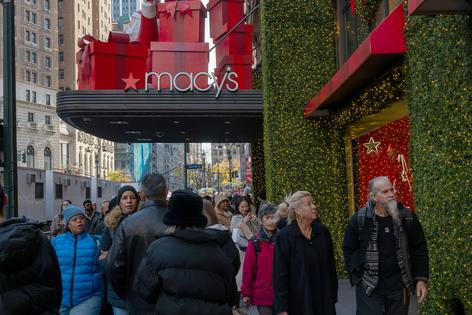Jill On Money: Holiday spending should confirm soft landing
The retail holiday season is well under way, and in the weeks ahead, we are going to learn whether or not consumers feel as glum about the economy as they said they did, prior to the election. (An October Gallup poll found that just over half of Americans said that they are worse off today than they were four years ago.)
Early estimates are for a so-so holiday spending season, with Deloitte predicting an increase of 2.3 to 3.3 percent from a year ago, which would represent a slowdown from last year’s 4.3% annual gain. As we have seen over the past two decades, e-commerce will grow faster (7-9%) than brick and mortar sales, and will probably reach another new record in 2024 ($240.8 billion), according to Adobe.
A clue to the 2024 holidays may be found in the hiring plans of major retailers. Outplacement firm Challenger, Gray & Christmas predicts that seasonal hiring will add 520,000 new jobs, lower than last year’s roughly 564,000 and the second-lowest total since 2009.
Still, Amazon announced that they are hiring “250,000 full-time, part-time, and seasonal roles” and Target, which just reported dreadful earnings, will supplement its ranks with “approximately 100,000 seasonal team members across our stores and supply chain facilities.”
But tellingly, the big kahuna, Walmart, which smashed earnings estimates, said that it would add only 40,000 seasonal workers. Those plans may indicate a larger concern among companies, both big and small, that many Americans are still hurting from the COVID-19 inflation surge and its curative high interest rates, which may mean that they will not be able to spend as freely as they would like.
Yes, everyone is relieved that the rate of price increases has come down significantly over the past 2½ years, but many are still grappling with elevated prices for everything from rent to insurance to child care. Confirming this lived experience is data: the Consumer Price Index (CPI) has jumped 22.9% from five years ago, almost three times the pace of the previous five-year period.
But don’t count out the American consumer! Sure, we hate high prices and indeed, the Thanksgiving meal costs more this year than it did in 2020 (tip: skip the cranberries, load up on the frozen peas), but wages have also increased for a lot of workers, which has partially reduced the sting of high prices.
Additionally, for many Baby Boomers, even those who are retired, the value of their retirement accounts and homes has boosted their net worth. Strategist Ed Yardeni notes that this group is “mostly happy now that they have paid off their mortgages, finished with college tuition, and seen their asset values soar.”
Bottom line: While we all gripe about high prices, enough of the population has been spending, propelling economic growth through this unusual period of high prices and high interest rates.
If enough consumers continue to show up for the 2024 holiday shopping season, it could further buoy the overall economy.
Last year, when I was writing about the 2023 holiday season, I said “consumers hold the key to the question of whether or not a recession is on the horizon for 2024. So far, there is little evidence that the consumer is rolling over and retrenching, which could mean that the much hoped for ‘soft landing’ may become a reality after all.”
It’s safe to say that 2024 should confirm the much desired “soft landing,” at least for now. What lies ahead is a bit murky, as a new administration enters the fray.
What happens next for the economy will depend on policies enacted in the months ahead.
_____
_____
========
(Jill Schlesinger, CFP, is a CBS News business analyst. A former options trader and CIO of an investment advisory firm, she welcomes comments and questions at askjill@jillonmoney.com. Check her website at www.jillonmoney.com)
©2024 Tribune Content Agency, LLC















Comments